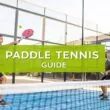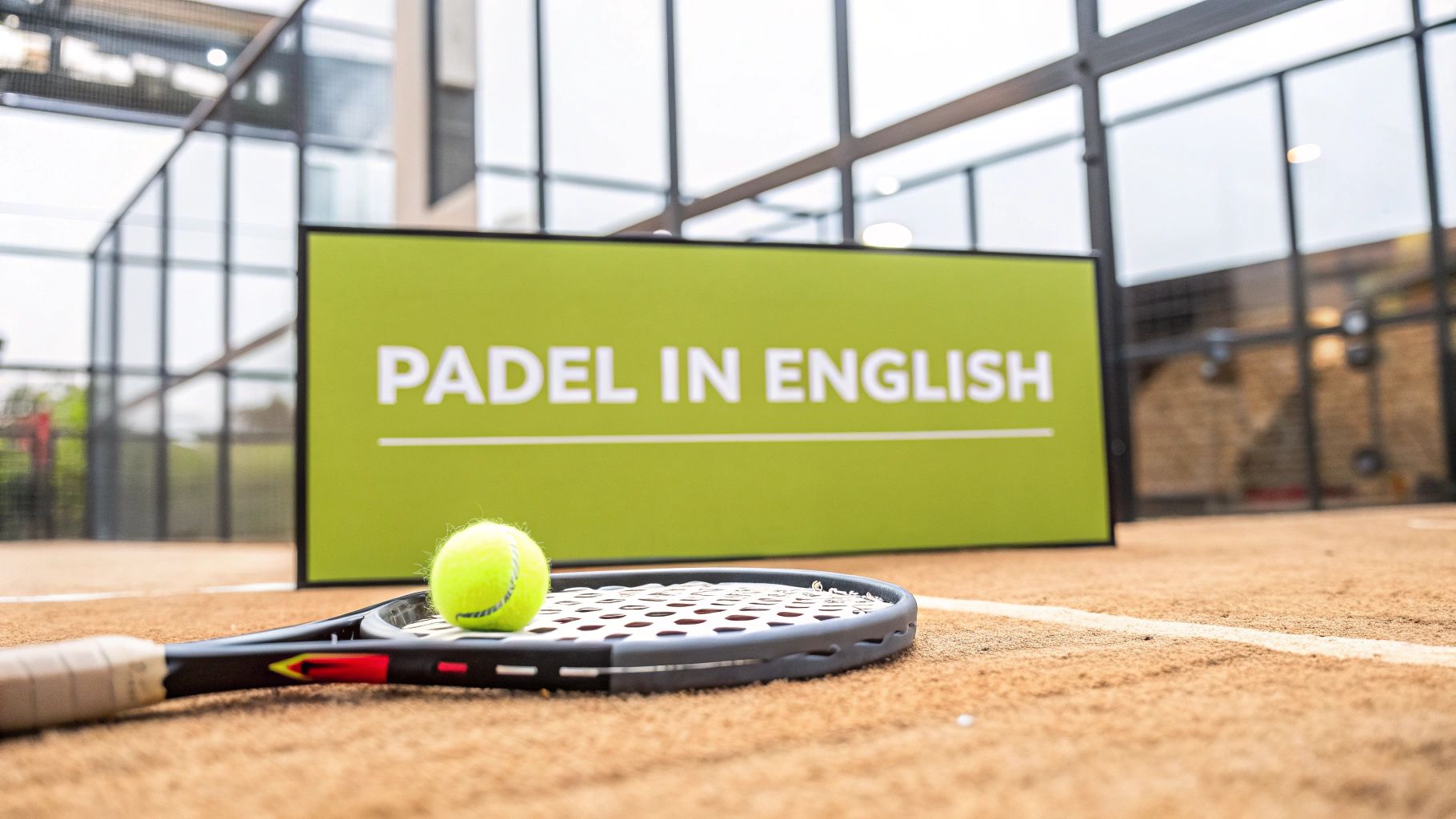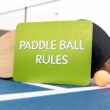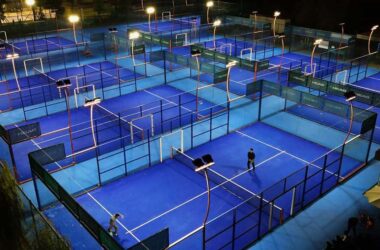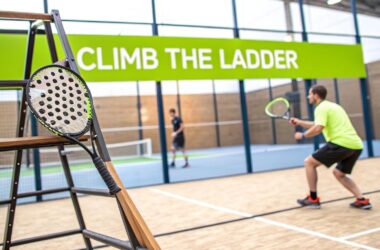Heard the buzz about a new racket sport taking over local clubs? You're not the only one. The short version is that padel is a fast, social, and ridiculously fun racket sport that mixes the best bits of tennis and squash into one addictive package. If you can picture tennis played inside a glass box, you’re on the right track.
What Is Padel and Why Is It So Popular?
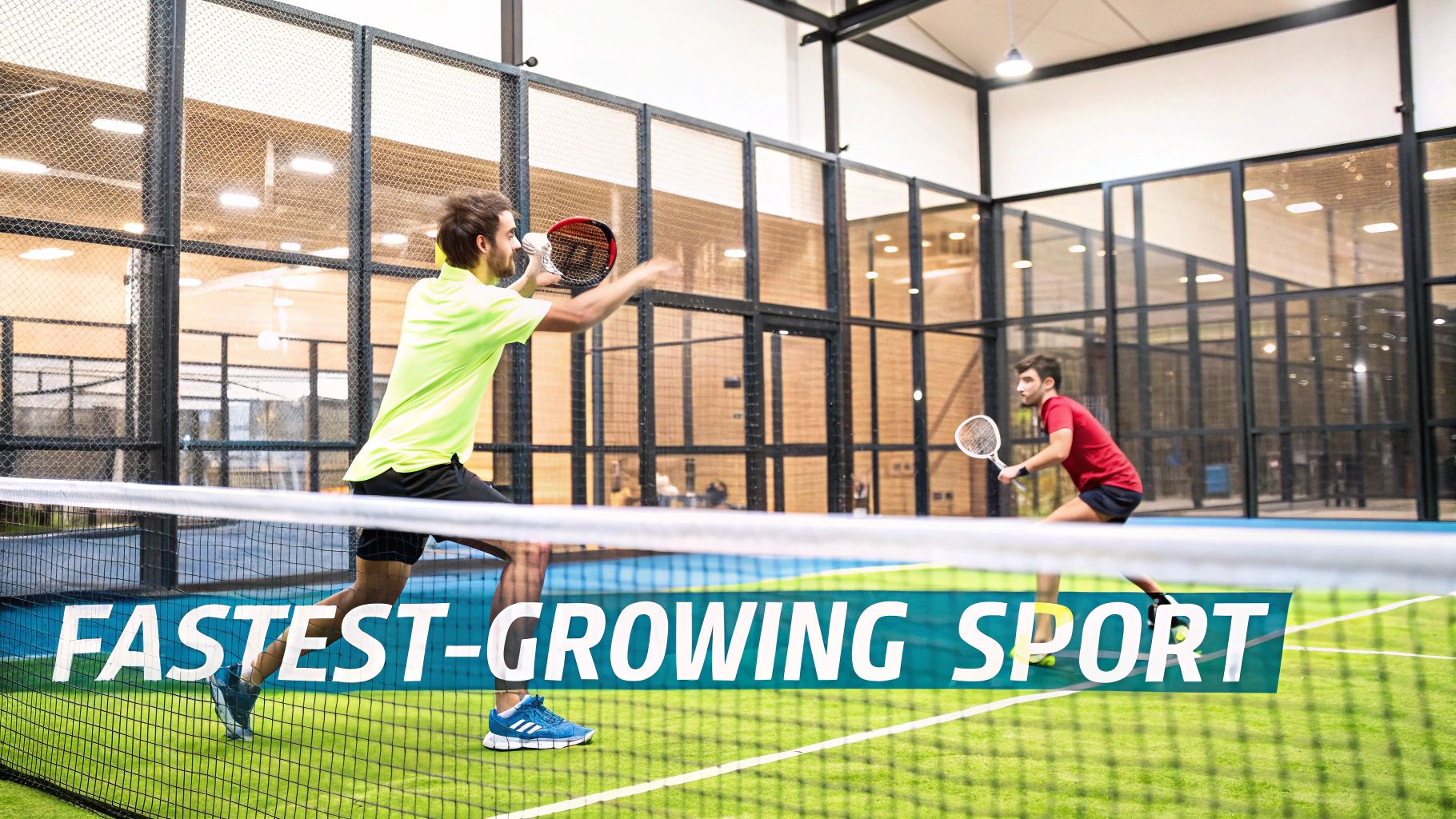
Padel isn’t just another game—it's a global sensation that has millions hooked with its unique mix of action and easy-going vibe. For English speakers just discovering the sport, its explosive growth can seem to come out of nowhere, but the reasons behind its popularity are crystal clear. Unlike tennis, which can take years of coaching to feel competent, padel has an incredibly gentle learning curve.
The game is always played in doubles on a court that's about a third of the size of a tennis court. It's enclosed by glass and mesh walls, which aren't just for show—they're a key part of the game. This smaller space and the ability to hit the ball off the walls means you get longer, more dynamic rallies right from the start, even if you’re a complete beginner.

Buy the best padel gear to level up your next game!
CHECK OUT this deal from Padel Market!Get ready to take your game to the next level with the latest padel gear from Padel Market! Fast EU and Worldwide Shipping
An Accessible and Social Sport
One of the biggest reasons for its growth is the social side of things. The court is small and you're always playing with three other people, so teamwork and communication just happen naturally. It makes for a brilliant community-building activity.
Padel's appeal is exploding, transforming from a niche sport into the world's fastest-growing. As of 2025, there are over 30 million players across 130 countries, and it's making serious headway in English-speaking markets like the UK and the US. The UK alone has around 400,000 active players, which shows just how fast padel is catching on. You can dive deeper into the sport's incredible rise and understand the key differences between padel and tennis in our related guide.
Padel's magic is in its simplicity. You can have a fun, competitive match within your first hour on the court, no matter your racket sport background. It’s an instant payoff that keeps people coming back for more.
Understanding the Court and Essential Gear
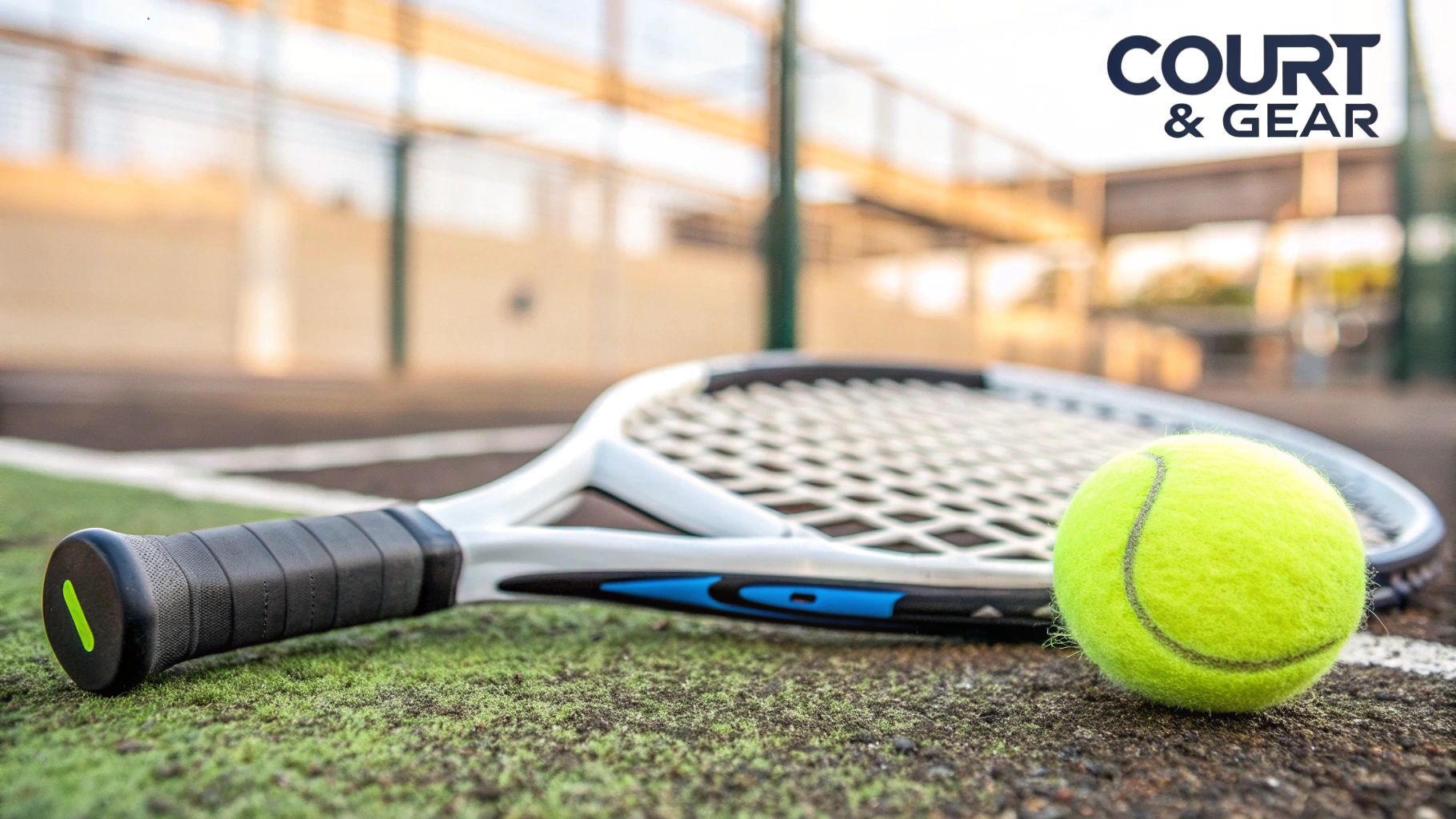
Before you even swing a racket, it helps to get the lay of the land and know your tools. The padel court is where the game’s unique personality really comes to life. It’s an enclosed rectangle, about a third of the size of a tennis court, which immediately creates a more intimate and fast-paced vibe.
The court is surrounded by walls, which are usually a mix of glass at the back and sides, with wire mesh fencing filling in the rest. These aren't just boundaries; they're an active part of the game. A bit like in squash, you can play the ball off the glass walls after it bounces once on your side, which opens the door for some seriously creative shots and long, exciting rallies.
If you really want to get into the nitty-gritty, you can explore the official padel court size and layout to understand the playing area inside and out.
Your Padel Equipment Essentials
The good news is that you don’t need a massive investment to get started in padel, but having the right gear definitely makes a difference. The equipment is purpose-built for the game and quite different from other racket sports.
The Racket (or Pala)
The first thing you'll notice is the racket, which is often called a pala in Spanish. Forget everything you know about tennis rackets—this one has no strings. It’s a solid paddle made from foam and composite materials, covered in holes to cut down on air resistance. It’s shorter and thicker than a tennis racket, which makes it much easier to handle right from the get-go. A crucial safety feature is the wrist strap, and you absolutely must wear it at all times.
For beginners, the best thing about the padel racket's design is how much control it offers. It’s far more forgiving than a stringed racket, making it way easier to hit the ball consistently, even in your very first game.
Balls and Shoes
Padel balls might look just like tennis balls, but they have slightly less pressure. This simple change means they bounce a bit less, which naturally slows the game down and gives you more time to set up your shots. It’s a huge help for new players.
For your feet, a good pair of tennis or court shoes with solid grip is your best bet. The artificial turf surface requires stability for all the quick side-to-side movements you’ll be making.
The Core Rules of Padel Explained Simply
Jumping into a new sport can feel a bit overwhelming, but you'll be happy to know the rules of padel are refreshingly simple. For English speakers just getting started, you really only need to get your head around three core concepts to play with confidence: the serve, the scoring, and the walls.
Nail these three, and you've basically got 90% of what you need for a fun, friendly match.
First things first, the serve. If you're used to the big, powerful overhead serves in tennis, you can relax. The padel serve is a gentle, underhand motion that's much easier to get the hang of. You just let the ball bounce once behind the service line, then hit it at or below waist level.

Buy the best padel gear to level up your next game!
CHECK OUT this deal from Padel Market!Get ready to take your game to the next level with the latest padel gear from Padel Market! Fast EU and Worldwide Shipping
Your serve needs to travel diagonally across the net and land in the opposite service box. If it takes a few tries to get it right, don't sweat it—it’s one of the quickest skills for new players to pick up. For a deeper dive, check out our guide on the complete padel serve rules and common faults to avoid.
Scoring and Playing Off the Walls
If you've played or even just watched tennis, you're already ahead of the game here. Padel uses the exact same scoring system: 15, 30, 40, and game. This makes it super easy for newcomers to keep track and focus on the rally instead of a confusing new point system.
Now for the really fun part—the walls. This is where padel truly comes into its own, blending the feel of tennis with the strategic angles of squash.
Here's the most important rule to burn into your brain: the ball must always hit the ground first before it can legally be played off any wall. You can't just smash the ball directly into your opponent's glass.
Once the ball has bounced on your side, you have the option of letting it rebound off the back or side glass walls before you return it. This completely changes the game. It adds a whole new strategic dimension, letting you turn a defensive scramble into a clever attacking shot.
Think of the walls as your teammates. Use them to your advantage. A well-played shot off the glass can change the pace and angle completely, keeping your opponents on their toes and making the rallies much longer and more exciting.
Key Padel Terms Translated into English
One of the quickest ways to feel like you belong on a padel court is to get a handle on the lingo. Since the sport blew up in Spanish-speaking countries, a lot of the essential terminology is, you guessed it, in Spanish. Picking up a few of these key phrases is a massive part of understanding padel in English and will help you keep up with the action from day one.
You don't need to be fluent in Spanish to play. Far from it. But knowing just a handful of the most common terms makes a world of difference. It helps you communicate with your partner and understand the strategy behind each shot. A literal translation often doesn't cut it, as these words describe very specific, tactical shots unique to padel.
Decoding Common Padel Shots
Many of the words you'll hear shouted across the court refer to specific shots, and each one has its own purpose. Instead of just memorizing vocabulary, it’s way more helpful to understand why a player chooses a certain shot. Are they trying to buy some time with a defensive play, or are they going for a killer strike to end the point?
This infographic is a great starting point, breaking down three of the most fundamental shots you’ll encounter.
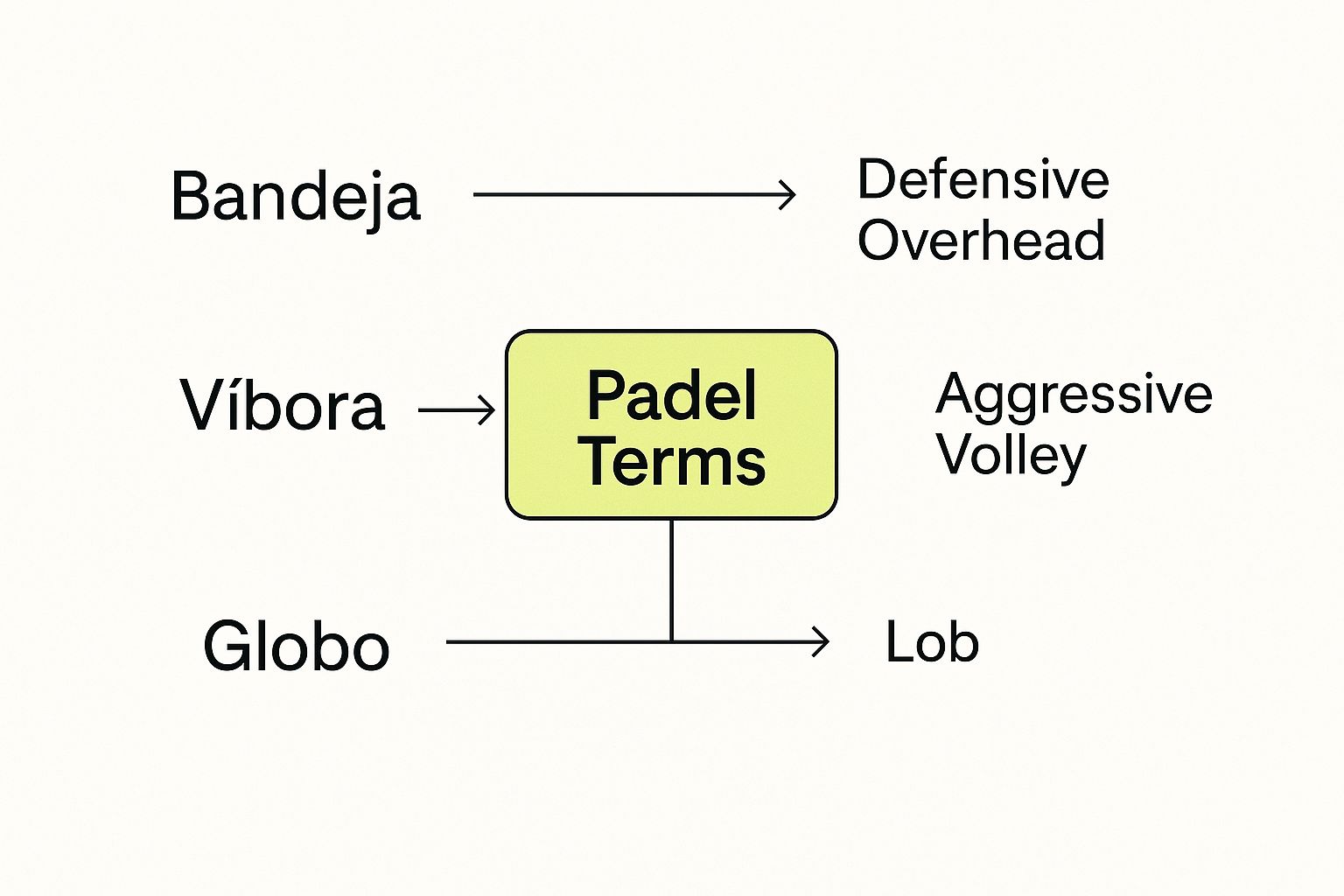
As you can see, terms like Bandeja, Víbora, and Globo aren't just fancy names. They each represent a distinct shot with a clear goal, from defensive overheads to aggressive, spinning volleys and high, tactical lobs.
Once you get the context behind these words, you stop thinking like a translator and start thinking like a padel player. You're not just hitting a ball; you're picking the right tool for the job.
To help you get up to speed, I've put together a quick-reference guide for the most common Spanish padel terms you'll hear.
Common Spanish Padel Terms and Their English Meanings
This table goes beyond just a direct translation. It explains what each term actually means in the middle of a game, so you can understand the flow of the match and communicate more effectively with your partner.
| Spanish Term | English Translation or Nickname | What It Means in Padel |
|---|---|---|
| Bandeja | Tray or Defensive Overhead | A controlled, slower overhead shot used defensively to maintain position at the net when you've been lobbed. |
| Víbora | Viper or Aggressive Volley | An aggressive overhead shot with heavy slice or spin, designed to skid low after hitting the glass and be difficult to return. |
| Globo | Lob | A high, deep, arcing shot intended to push your opponents back from the net, giving your team time to advance. |
| Chiquita | Little One or Dink | A soft, low, and short shot aimed at your opponents' feet, forcing them to hit up and creating an attacking opportunity. |
Keep these terms in mind next time you play or watch a match. Soon enough, they’ll feel like second nature.
The Social Appeal of Padel Explained
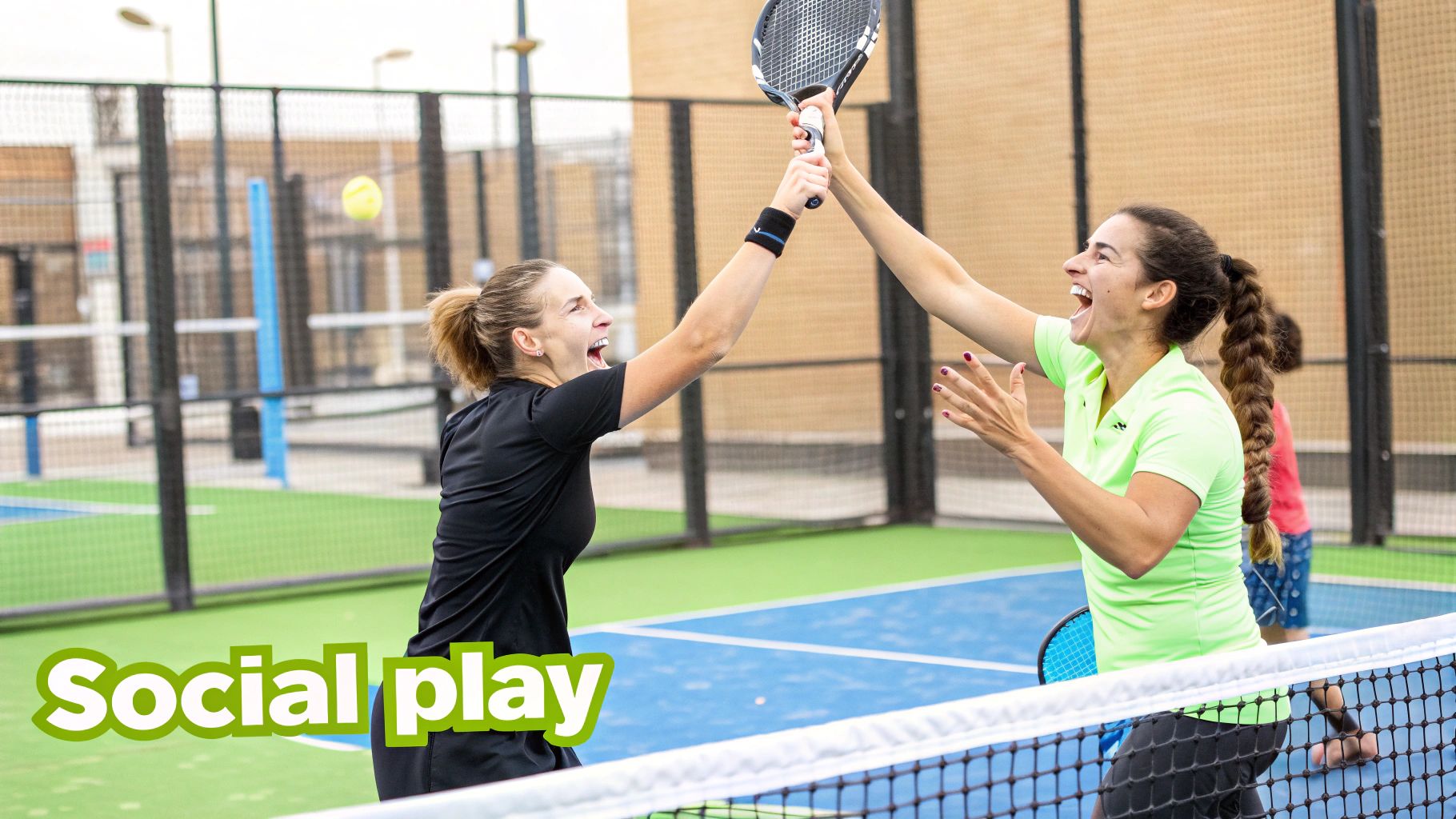
Beyond the rules and rackets lies the real secret to padel's explosive growth: it's an incredibly social sport. Sure, the dynamic rallies give you a great workout, but it's the human connection that truly gets people hooked. The game is less about individual power and more about teamwork, communication, and just having a good time together.
This social element is baked right into the game’s DNA. The court's smaller size and the mandatory doubles format naturally bring players closer, creating constant interaction. Unlike tennis, where you can feel isolated on your side of a massive court, padel keeps the conversation and camaraderie flowing between points.
The gentle learning curve is another massive factor. Newcomers can get enjoyable rallies going almost immediately, which means the focus shifts from wrestling with technique to simply having fun. This easy entry makes padel the perfect activity for building a community.
A Sport for Everyone
Padel's welcoming vibe has created a uniquely diverse crowd, breaking down barriers you often see in other sports. It’s not uncommon to see courts filled with players of all ages, from young adults to seniors, and a huge range of fitness levels all sharing a court.
The magic of padel is that it adapts to the players. A game can be a friendly, low-impact rally or a fiercely competitive athletic battle—all on the same court.
Demographically, padel really stands out. Around 40% of players worldwide are female, a remarkably high participation rate for any racket sport. On top of that, with over 70% of players being over the age of 25, it’s clear this is a go-to sport for adults looking for a fun and engaging way to stay active and connected. You can dive deeper into the numbers with these global padel statistics and player demographics on pala-hack.com.
Ultimately, it’s this blend of an easy start and a strong social core that keeps players coming back for more.
Common Questions for New Padel Players
Jumping into any new sport is going to come with a few questions. When you're learning about padel in English, a handful of the same queries always seem to pop up. Let's get those sorted out so you can step onto the court for the first time feeling confident and ready to play.
Getting Started on the Court
One of the biggest worries for newcomers is finding people to play with. Do you need to show up with a partner already? Not at all. Padel is a super social game, and most clubs have systems, often using apps, to help you find a match. You can just join an "open match" and get paired up with three other players around your skill level. It's a fantastic way to meet people.
Another thing people always ask is if padel is easier to learn than tennis. For most people, the answer is a huge "yes." The serve is a simple underhand toss, the court is smaller so there's less ground to cover, and the solid racket is a lot more forgiving. It’s not uncommon for total beginners to be having a proper rally in their very first session.
What's the most critical wall rule to get straight? The ball ALWAYS has to bounce on your opponent's side of the court before it hits any of their walls. After it bounces on the ground, you can let it rebound off the glass on your side before you hit it back over. Just remember: you can never hit the ball directly into your opponent's walls.
The good news is that finding a place to play is getting easier by the day. Padel is exploding globally, with the number of clubs surging. We're seeing a year-over-year increase of around 22-26% in new court construction. With the commercial market set to keep growing, access to the sport is only getting better. You can dive deeper into padel's impressive expansion on padel.fyi.
As you get into padel and meet new people at the club, you might also want to brush up on your social communication skills. For some simple, practical tips, you can learn more about English conversation for beginners.
At Padel Rumors, we provide all the news, guides, and gear reviews you need to master the game. Explore our resources to stay ahead of the curve at https://www.padelrumors.com.



